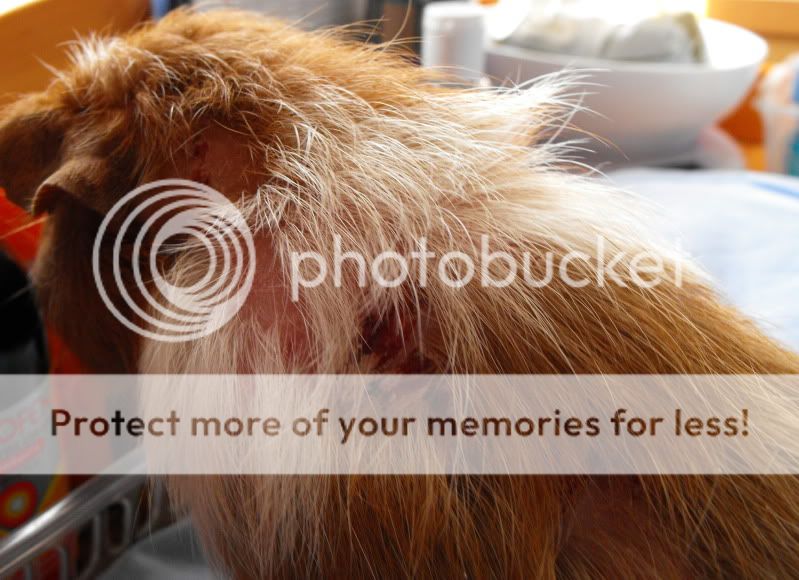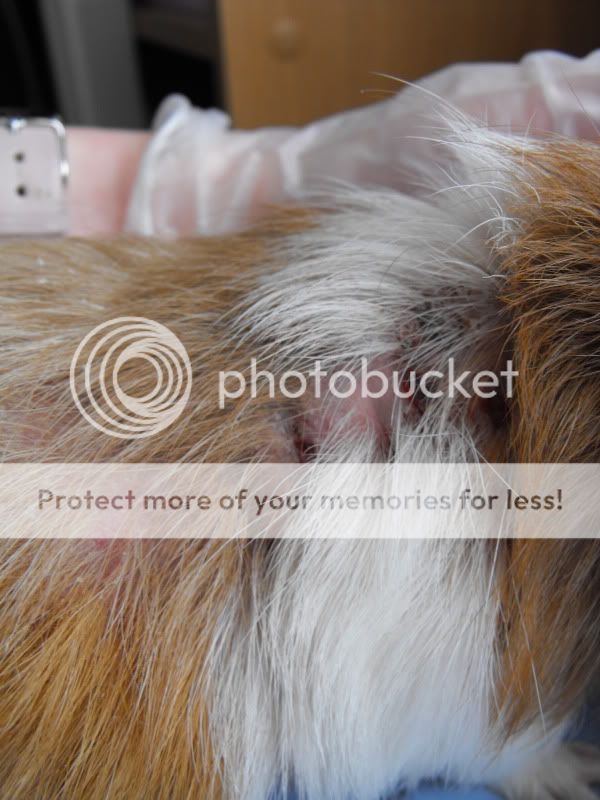Laura-CCC4
Senior Guinea Pig
With the permission of this pigs owner, I would like to use these pictures and the information I have learned, to highlight how mycotic (fungal) skin conditions that are not recognised and treated quickly, can become life threatening.
This pig came into my care for only a few hours, a temporary stop on his way to Vedra at the CCT. His condition was described in its earlier stages on the forum, the member was advised - by people including myself - that mites was possible, based on the symptoms described.
As it happens, the pig had a fungal skin infection, which, as it was not identified sooner, became severe. The humidity contributed to the rapid spread of the condition over the pigs body. His symptoms included:
- Heavy crusting of the skin (in places it was more like sand in texture);
- Widespread hair loss;
- Scabs and open lesions as a result of scratching;
- Seizures.
The following photos do not capture the true condition of the pig, look on it as a glimpse at how the symptoms can progress.




Treatment for this pig had to be intense and thorough; during bathing his remaining infected hair was pulled out, and he is now on antibiotics and an oral anti-fungal medication. His recovery is set to be a very long, slow process spanning many weeks.
Going back to the beginning, had this been identified and treated sooner, treatment would have been far less intense and stressful - for the pig and owner.
For a mild fungal skin complaint where symptoms are very mild and no open lesions are found, treatment may need only involve a bath in Nizoral or Alphosyl shampoo once a week for four weeks. Any infected hair must be pulled out while the pig is lathered up - to some this may sound barbaric, but it is not, for the simple fact that infected hair slides out of the hair follicles without resistance. If there is resistance when pulling on the hair, the hair does not need removing. Allow the shampoo to soak in for five minutes before rinsing the pig.
In cases where only one guinea pig in a group is showing symptoms, it is worth bathing all the other guinea pigs in the group in an anti-fungal shampoo at least once; however all guinea pigs will still need monitoring for any developing symptoms that suggest the fungal condition has spread.
Please note that this is not a fully comprehensive advice thread and further advice should always be sought if a fungal condition is diagnosed. Topics I have not covered here include: details of identifying fungal skin conditions, the treatment regime of severe fungal skin conditions, disinfecting cages/hutches/beddings/toys and the continuing aftercare required for fungal pigs.
This case should serve not only as a warning about how skin issues must be taken seriously, but it also goes to show how advice and opinions given on an internet forum are no replacement for a physical examination by someone competant in guinea pig skin issues (e.g. rodentologist/RHA, veterinarian).
Please don't let your guinea pig fall into into a life threatening condition, there is just no excuse. Not when there are people able to help, not when there is such a simple treatment plan that can stop this condition progressing.
This pig came into my care for only a few hours, a temporary stop on his way to Vedra at the CCT. His condition was described in its earlier stages on the forum, the member was advised - by people including myself - that mites was possible, based on the symptoms described.
As it happens, the pig had a fungal skin infection, which, as it was not identified sooner, became severe. The humidity contributed to the rapid spread of the condition over the pigs body. His symptoms included:
- Heavy crusting of the skin (in places it was more like sand in texture);
- Widespread hair loss;
- Scabs and open lesions as a result of scratching;
- Seizures.
The following photos do not capture the true condition of the pig, look on it as a glimpse at how the symptoms can progress.




Treatment for this pig had to be intense and thorough; during bathing his remaining infected hair was pulled out, and he is now on antibiotics and an oral anti-fungal medication. His recovery is set to be a very long, slow process spanning many weeks.
Going back to the beginning, had this been identified and treated sooner, treatment would have been far less intense and stressful - for the pig and owner.
For a mild fungal skin complaint where symptoms are very mild and no open lesions are found, treatment may need only involve a bath in Nizoral or Alphosyl shampoo once a week for four weeks. Any infected hair must be pulled out while the pig is lathered up - to some this may sound barbaric, but it is not, for the simple fact that infected hair slides out of the hair follicles without resistance. If there is resistance when pulling on the hair, the hair does not need removing. Allow the shampoo to soak in for five minutes before rinsing the pig.
In cases where only one guinea pig in a group is showing symptoms, it is worth bathing all the other guinea pigs in the group in an anti-fungal shampoo at least once; however all guinea pigs will still need monitoring for any developing symptoms that suggest the fungal condition has spread.
Please note that this is not a fully comprehensive advice thread and further advice should always be sought if a fungal condition is diagnosed. Topics I have not covered here include: details of identifying fungal skin conditions, the treatment regime of severe fungal skin conditions, disinfecting cages/hutches/beddings/toys and the continuing aftercare required for fungal pigs.
This case should serve not only as a warning about how skin issues must be taken seriously, but it also goes to show how advice and opinions given on an internet forum are no replacement for a physical examination by someone competant in guinea pig skin issues (e.g. rodentologist/RHA, veterinarian).
Please don't let your guinea pig fall into into a life threatening condition, there is just no excuse. Not when there are people able to help, not when there is such a simple treatment plan that can stop this condition progressing.

